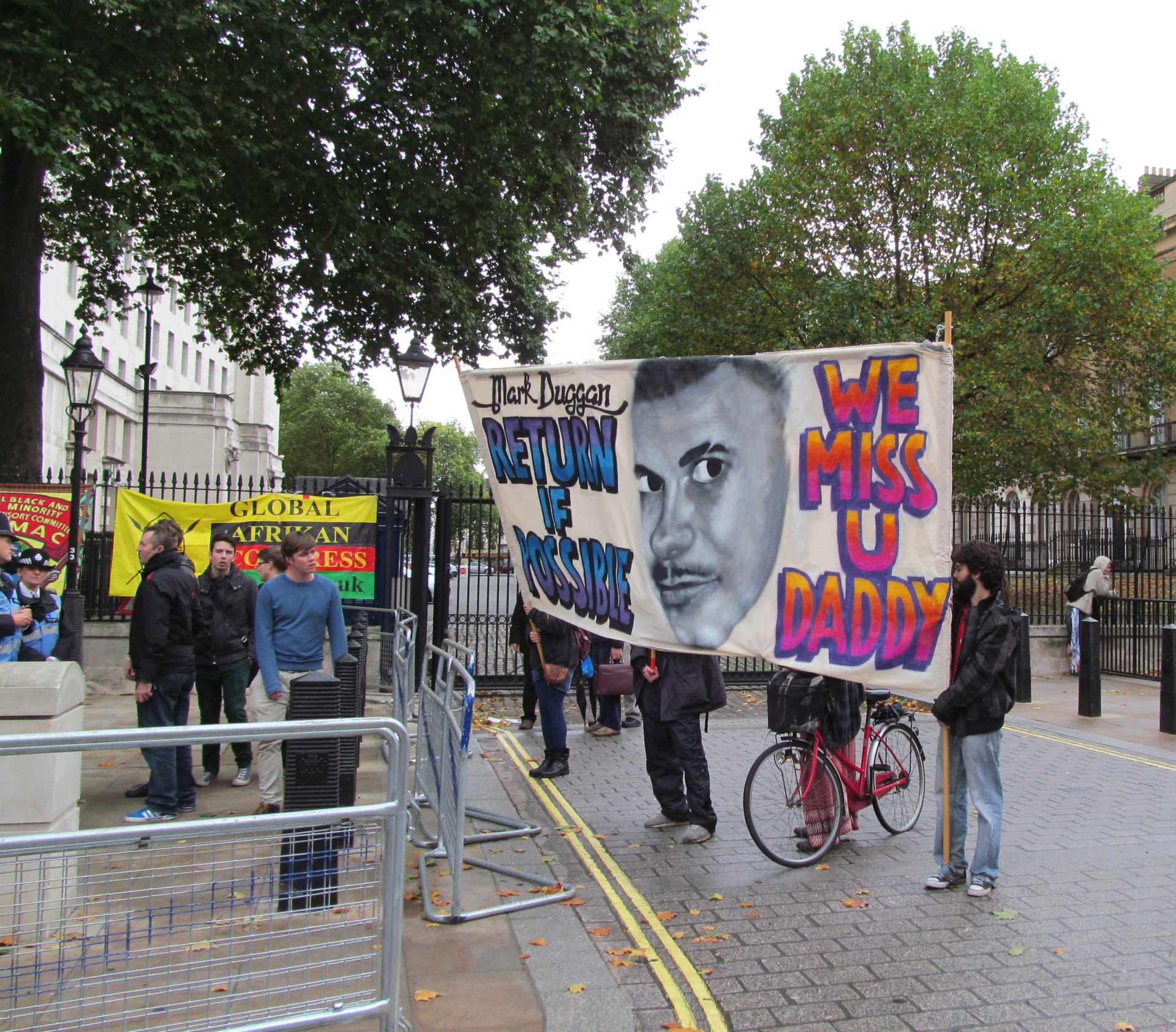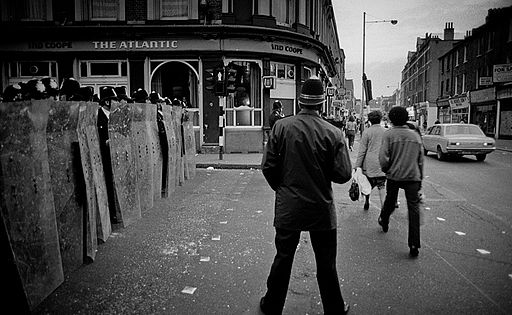No Justice, No Peace: Artistic response to anti-Black murder by police
Content warning: this piece focuses on anti-Black racism, police brutality, and murder.
This post continues our series from students on ‘Death, Dying and the Dead’, an MA history module at the University of Leeds. This post, by Martha Mitchell, focuses on how artists have responded to the deep-seated and persistent violence against Black communities by the police.
In June 2018, George the Poet, a spoken-word performer, was strip-searched in the back of a police van outside his parents’ house in West London. George responded to this incident through his podcast in the episode ‘It’s On Us’, George explored the relationship between police and Black communities, placing his experience into the wider schema of police violence. ‘It’s On Us’ weaves music, interviews and verse into a series of vignettes, one of which focuses on the 2011 England riots.
On August 4th, 2011, Mark Duggan, a twenty-nine year old Black man, was pulled over by officers from the Met’s ‘Trident Unit’. Then, in George’s words: ‘Mark started running for his life, but two shots caught him. One arm. One chest and now the unanswered question is: Why were shots fired at an unarmed suspect?’ [10:48-11:06]. The following evening a group of protesters gathered outside Tottenham police station looking for answers. As the sun went down, the police moved into the crowd. The balance shifted and a riot broke out with attacks on police cars and property. Over the next five nights, the riots spread from Haringey across London and beyond, resulting in the mass arrest of over 5,000 people.

Demonstration by the United Families and Friends Campaign (UFFC), 26 October 2013. Reproduced from Wikimedia Commons.
At the beginning of the vignette, George comments on how he reacted to the events of 2011:
I didn’t rate the riots of 2011 but I was praying for Mark Duggan’s entry to heaven. Most of the people rioting were cowards to me, I’m thinking why don’t you lot take this to the powers that be, you lot ain’t running up on no police stations, because you lot ain’t trying to have it out with police. [...] I was pissed off at the time. Pissed off that people’s hearts were hardened now. Pissed off that Mark’s family were targets now. [9:35-10:11]
His voice is distorted, as if coming over a megaphone, with the sound of sirens in the background. George stepped back in time to address the rioters telling them that there is a correct way to protest - ‘have it out with police’. His criticism appears to mirror what came to be the narrative of the riots: mindless consumerism and opportunistic violence.
George’s reaction is more nuanced. He shifts our focus back to Mark - to Mark’s death, family and memory. George refuses to lose sight of who Mark Duggan was. Other artistic responses, like Gillian Slovo’s play The Riots, focused heavily on the riots themselves, letting Mark’s death slip into the background. Often, when Black people die at the hands of police, they are transformed into caricatures: the press dehumanised Joy Gardner, who died in 1993 during an immigration raid. In contrast, as Jackie Wang argues, when the victim is deemed to possess an acceptable level of innocence, or can appeal to white ideals of acceptability, they become worthy symbols to mobilise anti-racist action. Kelso Cochrane and Stephen Lawrence, who were murdered in racist attacks in 1959 and 1993 respectively, came to represent victims of a brutish, unthinking racism and a state which didn’t care. In George’s experience with the police, newspapers emphasised George’s background as a Cambridge graduate: he had the acceptably middle-class markings of predetermined innocence. By refocusing on Mark, George denies both anti-Black demonisation of the dead and appeals to their innocence.
In the latter half of the vignette, George narrates the police cover ups and inconsistencies surrounding Mark’s death
One of the officers said they saw Mark pull a pistol from his waistband, implying that’s the reason for the fate that he suffered. But he never touched a gun as it was later discovered. [...] These statements were later rescinded. This kind of behaviour explains widespread inter-generational police hatred in England. [11:19- 12:35]
The blame is placed back with the police and their violent treatment of Black communities. Since the late 1970s, police have targeted Black areas such as Tottenham and Hackney with increased stop-and-search and plainclothes officers. It was the constant presence of undercover special patrol officers in Brixton which led to the riots in 1981, after officers prevented a stab-wound victim from getting to hospital before bleeding to death. Mark grew up on the Broadwater Farm estate where police murdered Cynthia Jarett in 1985, resulting in riots. He was part of a community that understood the historic violence of police.

Riot police on Coldharbour Lane, Brixton, 1981. Reproduced from Wikimedia Commons.
The vignette ends with verbatim clips from those who were out on the streets:
This all started because these feds shot my boy, innit.
We’ve all got a story to tell about the fucking police and individual brutality
You see when you treat people like animals, they start behaving like animals, exactly
We were all there, they just set the dogs on us innit. I’ve been bitten four times. [12:48-13:05]
From the implications of ‘cowardly’ violence at the start, George recasts the actions of the rioters as an appropriate outburst at policing that brutalises young Black men. Riots demand recognition and attention from the police, the state and the public. In the magazine endnotes, an anonymous article quotes the brother of Brian Douglas, who was killed by police. Douglas’ brother regretted stopping a crowd from rioting:
well I wonder, if I wasn’t so disciplined and organised and just allowed people to go and tear up the situation […] probably in hindsight that’s the best that could’ve been achieved, [...] And some property or whatever would’ve been destroyed and that would’ve represented the death of Brian
Rioting has the potential to become a form of mourning. Rioters refuse to let onlookers forget the deceased and their murder. No property damage is worse than the death of a loved one. No amount of broken glass is more reprehensible than the terror inflicted on Black people by the state. Looting and rioting directly take action against the violence of capitalism, poverty and wage-labour. As two girls interviewed in Croydon drinking looted booze on the third night of rioting said, they were 'showing the rich we can do what we want'.
‘It’s on us’ is a personal exploration of George’s nuanced emotions surrounding the 2011 riots. George relates his experience to Mark’s, and the experiences of all the people who took to the streets in 2011. The poem grapples with the closed ranks of the press and the police and the constant disregard shown for the lives of Black people. Police powers are still racist: stop-and-search, the ‘Gang Matrix’, and using drill music as criminal evidence in court. Rage at state violence and murder is always legitimate, no matter the form. If they don’t give us justice, we won’t give them peace.
